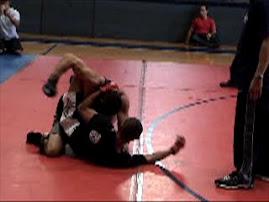Introduction
On August 15, 2009 Cristiane Santos and Gina Carano competed in a mixed martial arts match that had as much crowd anticipation and energy as virtually any men's match (see video, below).
While critics may suggest certain aspects of the match were sloppy or that the match did not yield pay-per-view buys on par with top UFC fight cards, one should also recall that generally speaking the women's MMA game has not been in play for nearly as long as the men's, and more importantly, as in most other sports, female athletes are not supported in the MMA industry as much as male athletes.
Since Zuffa (the UFC's parent company) announced earlier this month that it had subsumed the Strikeforce promotion, a number of analysts have discussed the precarious position in which fighters now see themselves (see for example, here). Narrowing the focus, a few pieces have noted the especially uncertain position of female fighters currently under the Strikeforce brand. Fowlkes' piece at MMAFighting.com offers particularly useful perspectives from three of Strikeforce's female fighters -- Sarah Kaufman, Marloes Coenen, and Miesha Tate:
"I think one of two things can happen," said former Strikeforce champ Sarah Kaufman. "The first is that they embrace the females and still try to push them using the Strikeforce venue and then maybe pulling them over [into the UFC]. That would be great, if that were to happen. The second option would be, they run the contracts out and then that's it. I'm definitely hoping for the former, but I'm preparing for the latter.""I believe that with the knowledge of the UFC, Strikeforce will grow even larger," said Coenen. "If Dana and the others see that women can bring him money, it will be good for us. What we need are the role models like Gina Carano and Miesha and hopefully me, as well, that women can relate to. ...I truly believe that if they can get the women's audience, and if they can identify with a girl next door like me or Miesha, then the female fanbase, which is way more loyal than the men are, will only grow from there. That's the way I think Dana and Zuffa should look at it."
"I know Dana White isn't a huge women's fighting advocate at all, and I know he's saying he'll honor the contracts, so immediately I don't think anything is going to change," said Tate. "But I'm a little concerned about when renegotiations come around for the women. I don't know how he's going to weigh our value and how we're going to get paid. I'm also more concerned about the big picture when the Showtime contract ends for Strikeforce. That's when I think there's going to be some big changes."
Tate's point regarding how female fighters are valued in the MMA indsutry can be further analyzed by examining female fighters' recent compensation in major MMA fight cards relative to their male counterparts.
Methodology
A more detailed description of the methods for this piece can be found here. In short, to collect data for this project, the available information was gathered from MMA websites for each fighter's publicly stated earned income from UFC 100 to UFC 127, as well as a sample of Strikeforce fighters' salaries who competed within the timeframe. Only major fight cards were examined for this project, essentially meaning cards that were held on a pay-per-view basis. As noted previously, following UFC 127, Zuffa L.L.C. purchased the Strikeforce promotion, thereby putting the UFC and Strikeforce under the same ownership banner.
For the UFC promotion, a sample of 15 fight cards were examined, in which 326 payouts (also known as a fighter's "purse") were made to fighters; fighter salaries for 13 UFC fight cards during this timeframe could not be located. For the Strikeforce promotion, a sample of 8 fight cards were examined, with 156 payouts. For Strikeforce, two payouts were discarded from the analysis (one in which the majority of the payout was reportedly given to charity and second of which was paid in advance of the competition), rendering this portion of the sample to 154 (Total N = 480).
Analyses for this article will compare 18 cases specific to female fighters, all in the Strikeforce promotion, in comparison to their male counterparts in Strikeforce (N = 136) and in comparison to the combined cases of males from the Strikeforce and UFC promotions (N = 462). There are a few important limitations to these methods. First, the public compensation made to fighters within the UFC promotion (as noted by commenters in the first article using this data set noted) does not include "backstage/locker room" bonuses that are given to select fighters by management. Nor does the data set include possible royalties that elite fighters may secure from pay-per-view buys, DVD sales, etc. (which would expand the stratification among fighters since lower-tier fighters would likely not secure such compensation). Finally, reflecting gender stratification, the sample size for female fighters is very small.
Results
As noted previously, among male athletes in the total sample (UFC and Strikeforce fighters) payouts ranged from $940 to $500,000. For female athletes (only Strikeforce fighters), payouts ranged from $1,000 to $125,000. Among the male sample, however, there were 34 cases in which males made at least $200,000 for one competition (30 cases specific to the UFC and 4 specific to Strikeforce). When only examining the male cases specific to the Strikeforce promotion, payouts ranged from $400,000 at the top (paid to Fedor Emelianenko in his loss to Fabricio Werdum) to $940. The following figures display the measures of central tendency and variance for the total sample of males (UFC and Strikeforce males combined), Strikeforce males, and Strikeforce females.
All males (N = 462)
- Mean: $54,109
- Median: $20,000
- Standard deviation: $85,443
Strikeforce males (N = 136)
- Mean: $25,576
- Median: $4,500
- Standard deviation: $57,608
All/Strikeforce females (N = 18)
- Mean: $16,608
- Median: $4,500
- Standard deviation: $29,379
The mean in all analyses is skewed heavily by outliers where fighters secured especially large purses relative to their co-workers. The median is a better measure of central tendency, and it is clear that the addition of UFC males to Strikeforce males alters the male sample, with the median standing substantially higher at $20,000. When comparing Strikeforce females with their male counterparts, the median is exactly the same, illustrating a degree of parity in compensation between the men and women.
However, it is also important to examine the standard deviation, which indicates the average dispersion from the mean. For Strikeforce males, the standard deviation is $57,608; for females it is much less, at $29,379. This means even though the standard deviation is quite large for the female sample, on average, female fighters tend to make more similar purses than men in the Strikeforce promotion.
Because the female sample is so small, it is useful to present all 18 cases:
- Gina Carano: $125,000
- Cris Santos: $35,000
- Cris Santos: $35,000
- Cris Santos: $25,000
- Sarah Kaufman: $20,000
- Cris Santos: $18,000
- Marloes Coenen: $10,000
- Jan Finney: $6,000
- Liz Carmouche: $5,000
- Elaina Maxwell: $4,000
- Marloes Coenen: $3,000
- Jenna Castillo: $3,000
- Germaine De Randamie: $3,000
- Marloes Coenen: $2,000
- Miesha Tate: $1,500
- Hitomi Akano: $1,450
- Charlene Gellner: $1,000
- Stephanie Webber: $1,000
Clearly this sample (both the mean and standard deviation) is skewed by Carano's purse of $125,000, which she earned in losing to Cris Santos. In fact, Carano's purse is more than 3.5 times higher than the next highest purse of $35,000 given to Cris Santos twice, and notably in both of those cases, Santos earned $15,000 to show, $15,000 to win, and a $5,000 championship bonus, so her income level was not guaranteed. If Carano's purse is omitted from the sample the mean drops to $10,232 and the standard deviation drops to $11,815 (the median only drops to $4,000).
Keeping Carano's salary of $125,000 in the female sample, a comparison of means was made between male and female Strikeforce fighters, and the differences were not statistically significant. Furthermore, even when omitting Carano's salary, a comparison of means between Strikeforce male and female fighters did not yield statistically significant results.
Thus, at least within the Strikeforce promotion, the data show that women were not paid less than men to a level that reached statistical significance prior to the promotion being subsumed by Zuffa. Still, a simple glance at the salaries illustrates the extensive range in salaries (high stratification) among female fighters, and the same is true for males.
Discussion
Carano's status as both an accomplished fighter and a sex symbol in the MMA game and broader popular culture at the time, clearly leveraged her more power to garner the disproportionate purse. One might argue that Carano made a "patriarchal bargain" to secure her lucrative contract. As Wade notes, "A patriarchal bargain is a decision to accept gender rules that disadvantage women in exchange for whatever power one can wrest from the system. It is an individual strategy designed to manipulate the system to one’s best advantage, but one that leaves the system itself intact."
Without question, Carano's emphasized femininity outside of sport increased her value within a sport that is particularly male-heavy (from ownership, through management, referees, athletes, and fans). This does not detract from Carano's general success as a competitor who was undefeated prior to squaring off with Santos. However, if sporting value is contingent predominantly (or at least largely) upon athletic success, one might rightfully ask why Santos continues to make so much less in comparison since defeating Carano. Additionally, Carano's participation in MMA (significant as it is) has not altered the sport's gender order.
Additionally, the data supports a question asked previously – how will Zuffa value female fighters in the future, in particular after female fighters' contracts expire. At least from a statistical standpoint, Srikeforce compensated the female fighters on their cards as a whole on par with their male fighters. This does not necessarily mean every individual fighter (male or female) was compensated fairly (fair pay encompasses a number of subjective factors). However, looking at the Strikeforce female and male groups, there was a degree of parity in compensation.
Will female fighters under Zuffa continue to be compensated with a degree of parity in the near future while contracts are still being honored? If not, why not? And in the long-term future, the bigger question is what will happen to women's MMA in general? Within the United States will women's MMA be limited to Bellator and regional promotions? Or will we see some of the more exciting competitions that women's MMA has provided for MMA fans in Strikeforce and the UFC? I'm hoping for the latter. And if the latter does come to fruition, that female fighters aren't making "$0.70 for every males' dollar."







Thank's for information!
ReplyDeleteCheck:
cloning essay